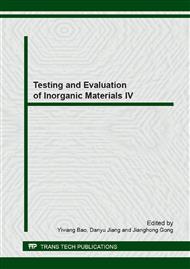p.176
p.180
p.185
p.190
p.194
p.200
p.204
p.208
p.212
Preparation and Electrical Properties of Sr2KNb5O15 Ceramics by Molten Salt Method
Abstract:
Sr2KNb5O15 ceramic powders have been synthesized by molten salt method, ceramics were sintered via a pressureless sintering method. The effect of calcining temperature on the phase composition and microstructure of ceramic powders were investigated by XRD and SEM analysis. The results show that microstructure of ceramic powders changed from acicular to platy, and the average size of ceramic powders become bigger with the calcining temperature increased. The optimal calcining temperature was 1200°C, and the length and diameter of ceramic powders was about 1-5 mm and 0.2-1 mm, thus the aspect ratio of ceramic powders was about 1-5. The influence of sintering temperature on density, microstructure and electrical properties of the ceramics were systematically analyzed. The results indicate that density and electrical properties of the ceramics first increased then decreased with increasing the sintering temperature. When the sintering temperature was 1400°C, the ceramics show optimized relative density and electrical properties (d33=40 pC/N, er=616, tand=0.029, Ec=9.83 kV/cm, Pr=32.50 mC/cm2).
Info:
Periodical:
Pages:
194-199
Citation:
Online since:
November 2013
Price:
Сopyright:
© 2014 Trans Tech Publications Ltd. All Rights Reserved
Share:
Citation:


